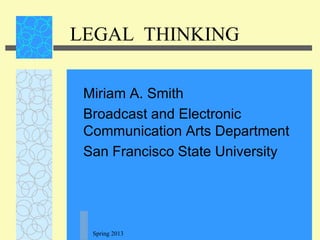
Legal Thinking 2013
- 1. LEGAL THINKING Miriam A. Smith Broadcast and Electronic Communication Arts Department San Francisco State University Spring 2013
- 2. The Nature of Legal Thinking What is legal thinking? How is legal thinking different from other types of thinking? How is legal thinking learned? Spring 2013
- 3. What is Legal Thinking? The way lawyers think – Lawyers carefully analyze the facts How are the facts at hand the same or different from the facts of a particular case? An analytical model Spring 2013
- 4. How do Lawyers Think? Lawyers ask many questions. – Is this a good case? – Can it be proven in court? – Is it likely to achieve the result the client desires? – Can the client pay? Is a judgment collectible? Spring 2013
- 5. How are the facts at hand the same or different from the facts of a particular case? Think it through. Consider all the angles. Anticipate all arguments. Spring 2013
- 6. How is Legal Thinking different? You tell me. Spring 2013
- 7. How is Legal Thinking Learned?
- 8. How is Legal Thinking Learned? Law school or by studying legal decisions. Three most important things I learned in law school . . . – Reasonable minds can differ. – There are at least two sides to every story. – Pigs get fat and hogs get slaughtered. Spring 2013
- 9. What about all that legal mumbo jumbo? a.k.a. the fine print Spring 2013
- 10. legalese All professions have their jargon – Terms of art – distinguish those in the profession We will learn many legal terms this semester Spring 2013
- 11. We’ll try some legalese . . . I, being of sound and disposing mind and memory, not acting under duress, menace, fraud, or the undue influence of any person or persons whatsoever, do hereby make, publish, and declare this to be my last will and testament, hereby revoking all wills and heretofore made by me, and give devise and bequeath the residue of my estate and all my earthly possessions consisting in whole of my three bags full of wool in the following manner: – a. One for the The Master – b. One for the Dame – c. One for the little boy who lives down the lane Signed on the 11th day of June, 2002.
- 12. Last Will and Testament
- 14. One more Sentence Peter (alias Peter), known for his peculiar propensity for the consumption of a variety of squash known colloquially as pumpkin, was in possession of a spouse who was a compulsive fugitive. He imprisoned her within the confines of a shell from a fruit of Curcurbita pepo, where she is now serving time under maximum security. Spring 2013
- 17. Our Legal Thinking Model Facts Issue Rule of Law Analysis Conclusion Spring 2013
- 18. Just the Facts Ma’am . . . A different set of facts will yield a different result. One fact alone can make all the difference. Some facts are more important than others. Fall 2010
- 19. Issue What must the court decide? What question or questions must be answered? Spring 2013
- 20. The Rule of Law Isthere a rule (i.e., law) that applies? What is that rule (law)? Spring 2013
- 21. Analysis A clear, logical explanation of the reasoning of the court. – Explains the rule of law. – Considers the arguments of the parties. Why did the court decide the way it did? Spring 2013
- 22. How judges think . . . How has the rule of law been applied before? – Precedent How should it be applied in this instance? – What is the same as and what is different from earlier cases? Spring 2013
- 23. – What is the rationale for the rule? What are the primary defenses to the rule? – Do they apply? Spring 2013
- 24. No precedent A case of first impression . . . – Situation sense – Fairness between these parties – Public Policy Spring 2013
- 25. Conclusion Summary of what happened. Decisions we read are almost always appellate decisions. Lower court’s decision is upheld, reversed or remanded. Spring 2013
- 26. Preliminary Facts Supreme 1893 Nix-- merchant Hedden -- tax collector Spring 2013
- 27. Facts Tax collector charged tax on tomatoes Charged “vegetable” tax Plaintiff claims tomatoes are a fruit, not a vegetable Spring 2013
- 28. Issue Are tomatoes a fruit or a vegetable? Spring 2013
- 29. Rule of Law Tariff Act Spring 2013
- 30. Analysis Considered the meaning of “fruit” and “vegetable” in the trade (and in the dictionaries) Consumer use of tomatoes – Used as a vegetable – Not really a dessert Tomatoes are a “fruit of the vine” Spring 2013
- 31. Conclusion Tomatoes are a vegetable Judgment of lower court affirmed (plaintiff loses) Spring 2013
Hinweis der Redaktion
- Dorothy M Wheeler illustration (Wikimedia)
